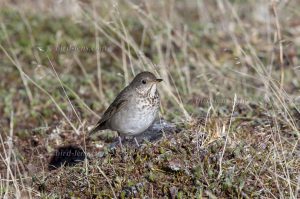 This medium-sized thrush with its brownish-grey upperparts and tail, its pale underparts with heavier spotting on the breast, a plain grey face with some light streaks but no eye-ring would be a real mega – if identified as such in the Western Palearctic. Grey-cheeked Thrushes (Catharus minimus) are rare vagrants to the WP, with only a few records each year. All recent sightings were noticed from – sometimes – remote islands in the Atlantic as from Corvo on the Azores, St Agnes from the Isles of Scilly, Ireland, Iceland, Fair Isle or Orkney (both Scotland). Most sightings are from the fall migration with a peak at the end of October but with possibilities between end of September and the beginning of November. A record from May – as happened on the May, 26th 2015 from the County Mayo on Ireland is a real exception.
This medium-sized thrush with its brownish-grey upperparts and tail, its pale underparts with heavier spotting on the breast, a plain grey face with some light streaks but no eye-ring would be a real mega – if identified as such in the Western Palearctic. Grey-cheeked Thrushes (Catharus minimus) are rare vagrants to the WP, with only a few records each year. All recent sightings were noticed from – sometimes – remote islands in the Atlantic as from Corvo on the Azores, St Agnes from the Isles of Scilly, Ireland, Iceland, Fair Isle or Orkney (both Scotland). Most sightings are from the fall migration with a peak at the end of October but with possibilities between end of September and the beginning of November. A record from May – as happened on the May, 26th 2015 from the County Mayo on Ireland is a real exception.
A trip to the tiny village of Gambell on the north-western tip of the big St. Lawrence Island in the middle of the Bering Sea yielded Grey-cheeked Thrush as the only representative of Catharus – Thrushes. Some tough birders flew in from the end of May to observe mainly the seabird migration. But during our seven-day stay on the Gambell– led by a guide from High Lonesome Tours – we could observe many more species migrating to their breeding grounds in the tundra landscape of eastern Siberia and Alaska.
The passerine birds we encountered on Gambell might be not as spectacular as the Siberian Rubythroat (Luscinia calliope) and the 2 Northern Wheatear (Oenanthe oenanthe) we observed on the Pribilof Islands some days before. But for the sole WP-birder of the group this was a perfect situation to twitch this beautiful but inconspicuous Thrush.
It is said, that the Grey-cheeked Thrush is quite a shy species, especially during migration. This Thrush is the least well studies of the spotted thrushes (Catharus sp.), and has the most northern breeding range stretching across the taiga from Newfoundland to eastern Siberia. The non-breeding range is not well known, but includes parts of northern South America east of the Andes from Colombia to northwestern Brazil.
As similar species to the Grey-cheeked Thrush Bicknell’s Thrush (Catharus bicknelli), Swainson’s Thrush (Catharus ustulatus), Hermit Thrush (Catharus guttatus) and Veery (Catharus fuscescens) are possible and might give you a hard job to ID. Swainson’s Thrush has similar markings and coloring, but the face is buffy with a distinct buffy eye-ring. The Hermit Thrush has a distinct rusty tail and the Veery is usually more reddish overall but shows some comparable features as the plain face and the spotting on the breast.
To cope with the growing demand for top shots of the rarer species of the Palearctic Bird-Lens is keen to enrich the range of pictures of birds you can find in the Western Palearctic. Trips to remote places or to common – but underestimated locations as described above – to capture images of rare birds of Western Palearctic were very successful. The nice images you find in the gallery are only a first impression, what you will find in the gallery in the “Picture Shop” very soon. Just give me a message, if bird-lens.com could serve you with an image needed before the new pictures are online.